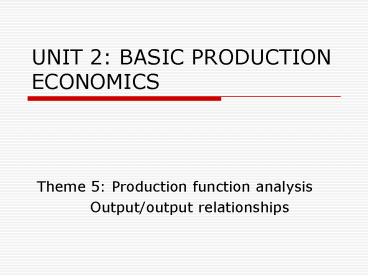UNIT 2: BASIC PRODUCTION ECONOMICS PowerPoint PPT Presentation
1 / 15
Title: UNIT 2: BASIC PRODUCTION ECONOMICS
1
UNIT 2 BASIC PRODUCTION ECONOMICS
- Theme 5 Production function analysis
- Output/output relationships
2
Output/Output relationships What to produce
- The question to ponder on how to use inputs
between different options of output. - One can use all the inputs to produce one output
or can use them to produce more than one output. - This gives you the production possibility curve
3
Joint products
Y2
0
Y1
A fixed amount of Y2 will follow on the
production of Y1 at a certain input level (Beef
and hides)
4
Supplementary products
Y2
Supplementary areas
0
Y1
If Y1 changes without changes in Y2 (Goats and
cattle grazing habits different)
5
Complimentary products
Y2
Complementary area
0
Y1
Production of one is to the advantage of the
other one (Goats and cattle goats prevent bush
encroachment, more grass for cattle)
6
Antagonistic products
Y2
0
Y1
Production of Y1 uses inputs of Y2 and also leads
to a decrease in the production of Y2 (Animals
carrying diseases which kill other animals)
7
Competing products (NB)
Y2
Y1
0
Increase in production of Y1 lead to a decrease
in production of Y2 Decision rule Profit is
maximized where the physical substitution rate
between two products is equal to the inverse of
the price relationship of the product
8
- Max profit combination
- ?Y2 PY1
- ?Y1 PY2
9
Graphically
Product Y2
Iso-product curve
A
Production possibility curve
0
Product Y1
10
The choice of the optimum profit combination of
products with fixed number of available inputs
Wheat price R0.42/kg Maize price R0.24/kg
11
Conclusion
- The maximum profit combination for a number of
products if inputs are limited - ?Y1PY1 ?Y2PY2.?Yn.Pn
12
Economies of scale
- Economies of scale is concerned with determining
the most profitable size of a business - Return to scale parameter
- Percentage change in cost (R)
- Percentage change in production value (R)
13
Three general rations
- Decreasing cost or increasing returns-to-scale
(rationlt1) - Constant cost or constant returns-to-scale
(ratio1) - Increasing cost or decreasing return-to-scale
(ratiogt1)
14
Graphical illustration
Decreasing cost
Constant cost
Increasing cost
Cost (R)
Economies of scale
Diseconomies of scale
Long-term ATC
A
B
0
Size of business
15
Note
- When the cost decreases, the average cost per
unit of output will decrease, so that the
average profit per unit of output increases - Economies of scale occurs in an area where
characterised by decreasing cost or increasing
returns to scale - As the size of the business increases in size,
the long-term ATV reaches a minimum, where it
temporarily stabilises

